Assessing Service Quality Dimensions' Impact on Customer Satisfaction
VerifiedAdded on 2021/08/19
|12
|5263
|58
Report
AI Summary
This report, based on a study published in "Studies in Business and Economics," investigates the influence of service quality dimensions on customer satisfaction within the commercial banking sector of Mauritius. Employing the SERVQUAL model, the research examines the impact of reliability, responsiveness, assurance, empathy, and tangibility on customer satisfaction, using a sample of 200 banking customers. The study, analyzed through SPSS version 22, reveals a positive and significant impact of all five service quality factors on customer satisfaction. Regression analysis further identifies empathy as a significant predictor among the dimensions. The paper highlights the importance of service quality in the competitive banking landscape and provides insights for banks to improve customer satisfaction by focusing on key dimensions such as empathy, which is a key factor in improving the quality of service.
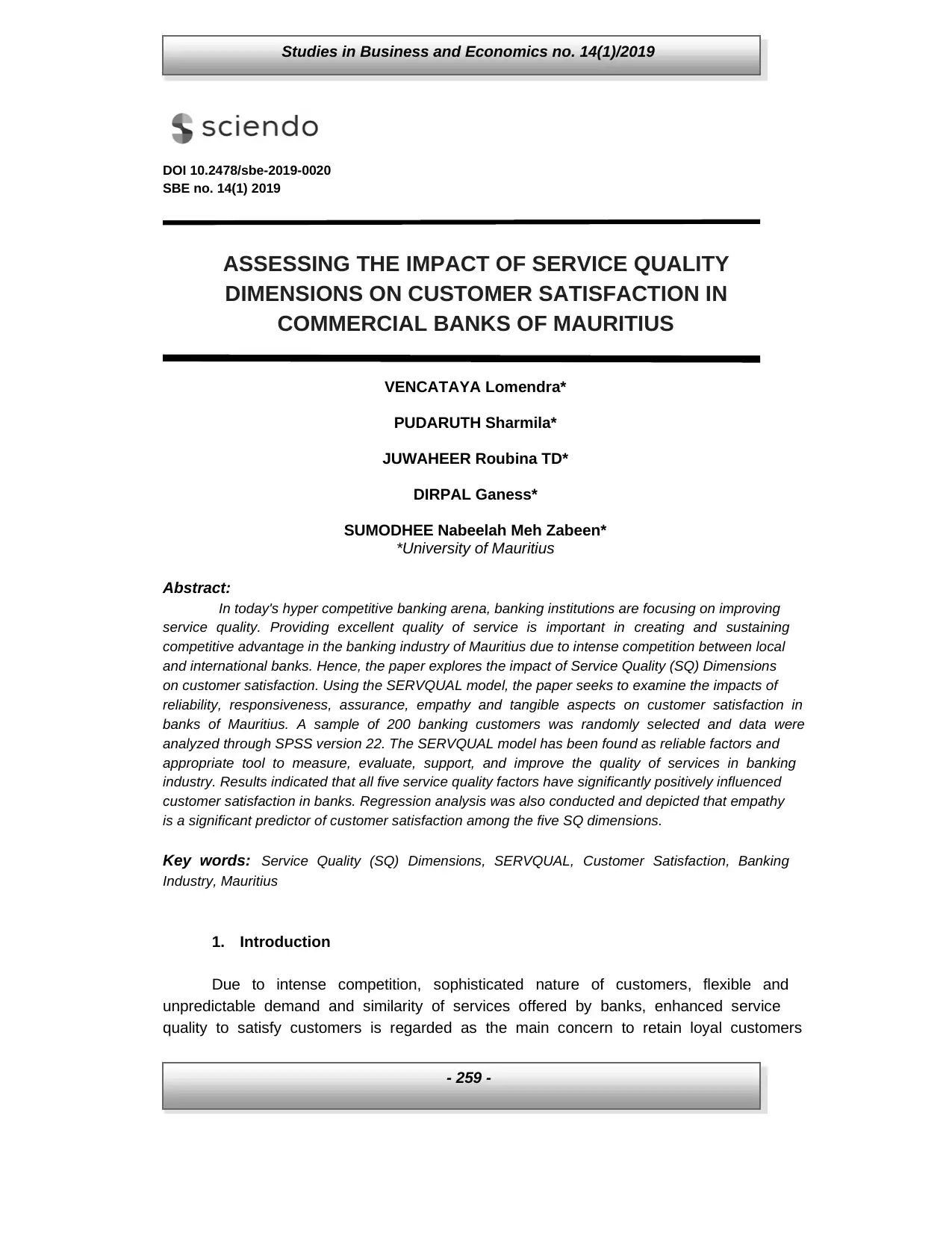
Studies in Business and Economics no. 14(1)/2019
- 259 -
DOI 10.2478/sbe-2019-0020
SBE no. 14(1) 2019
ASSESSING THE IMPACT OF SERVICE QUALITY
DIMENSIONS ON CUSTOMER SATISFACTION IN
COMMERCIAL BANKS OF MAURITIUS
VENCATAYA Lomendra*
PUDARUTH Sharmila*
JUWAHEER Roubina TD*
DIRPAL Ganess*
SUMODHEE Nabeelah Meh Zabeen*
*University of Mauritius
Abstract:
In today's hyper competitive banking arena, banking institutions are focusing on improving
service quality. Providing excellent quality of service is important in creating and sustaining
competitive advantage in the banking industry of Mauritius due to intense competition between local
and international banks. Hence, the paper explores the impact of Service Quality (SQ) Dimensions
on customer satisfaction. Using the SERVQUAL model, the paper seeks to examine the impacts of
reliability, responsiveness, assurance, empathy and tangible aspects on customer satisfaction in
banks of Mauritius. A sample of 200 banking customers was randomly selected and data were
analyzed through SPSS version 22. The SERVQUAL model has been found as reliable factors and
appropriate tool to measure, evaluate, support, and improve the quality of services in banking
industry. Results indicated that all five service quality factors have significantly positively influenced
customer satisfaction in banks. Regression analysis was also conducted and depicted that empathy
is a significant predictor of customer satisfaction among the five SQ dimensions.
Key words: Service Quality (SQ) Dimensions, SERVQUAL, Customer Satisfaction, Banking
Industry, Mauritius
1. Introduction
Due to intense competition, sophisticated nature of customers, flexible and
unpredictable demand and similarity of services offered by banks, enhanced service
quality to satisfy customers is regarded as the main concern to retain loyal customers
- 259 -
DOI 10.2478/sbe-2019-0020
SBE no. 14(1) 2019
ASSESSING THE IMPACT OF SERVICE QUALITY
DIMENSIONS ON CUSTOMER SATISFACTION IN
COMMERCIAL BANKS OF MAURITIUS
VENCATAYA Lomendra*
PUDARUTH Sharmila*
JUWAHEER Roubina TD*
DIRPAL Ganess*
SUMODHEE Nabeelah Meh Zabeen*
*University of Mauritius
Abstract:
In today's hyper competitive banking arena, banking institutions are focusing on improving
service quality. Providing excellent quality of service is important in creating and sustaining
competitive advantage in the banking industry of Mauritius due to intense competition between local
and international banks. Hence, the paper explores the impact of Service Quality (SQ) Dimensions
on customer satisfaction. Using the SERVQUAL model, the paper seeks to examine the impacts of
reliability, responsiveness, assurance, empathy and tangible aspects on customer satisfaction in
banks of Mauritius. A sample of 200 banking customers was randomly selected and data were
analyzed through SPSS version 22. The SERVQUAL model has been found as reliable factors and
appropriate tool to measure, evaluate, support, and improve the quality of services in banking
industry. Results indicated that all five service quality factors have significantly positively influenced
customer satisfaction in banks. Regression analysis was also conducted and depicted that empathy
is a significant predictor of customer satisfaction among the five SQ dimensions.
Key words: Service Quality (SQ) Dimensions, SERVQUAL, Customer Satisfaction, Banking
Industry, Mauritius
1. Introduction
Due to intense competition, sophisticated nature of customers, flexible and
unpredictable demand and similarity of services offered by banks, enhanced service
quality to satisfy customers is regarded as the main concern to retain loyal customers
Paraphrase This Document
Need a fresh take? Get an instant paraphrase of this document with our AI Paraphraser
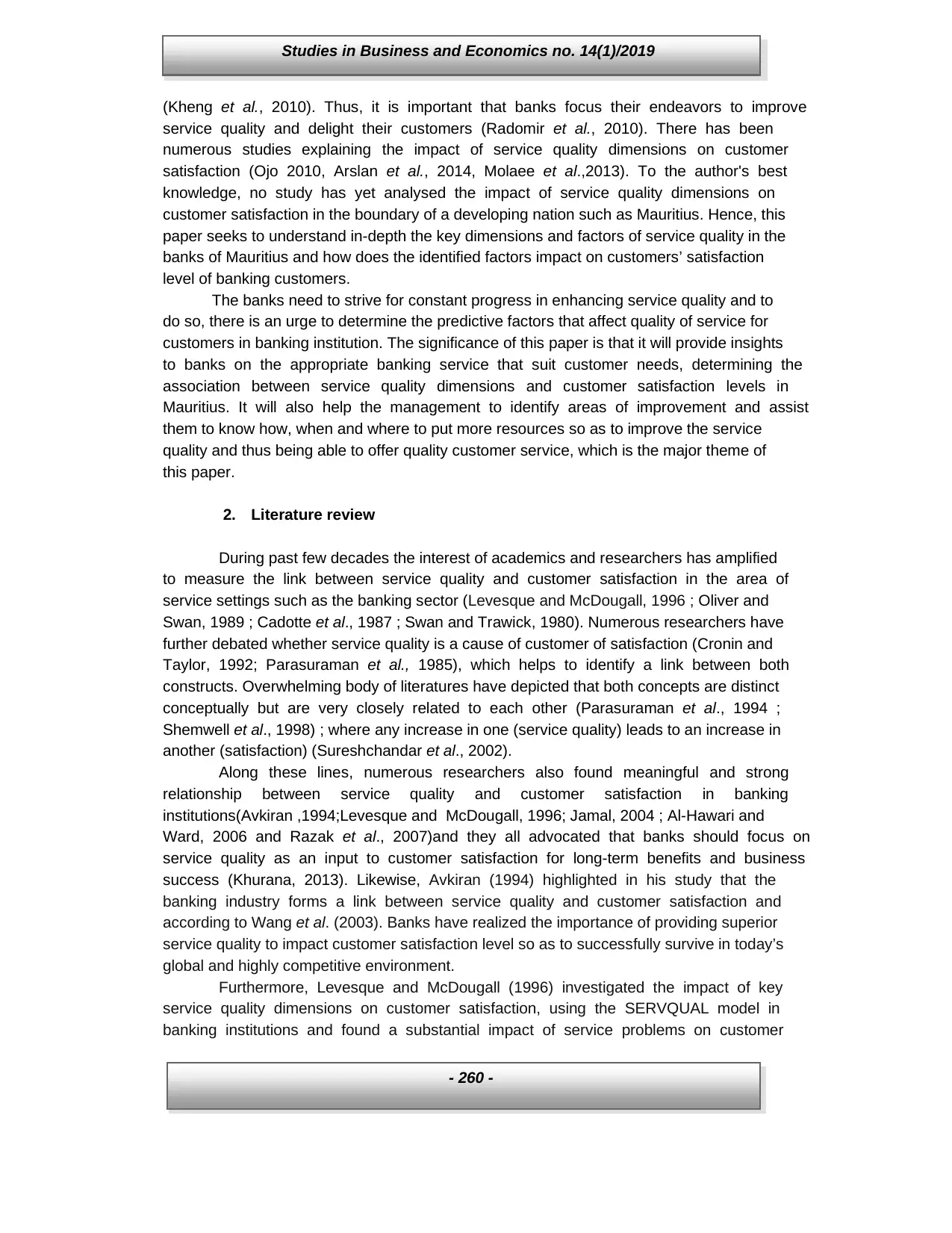
Studies in Business and Economics no. 14(1)/2019
- 260 -
(Kheng et al., 2010). Thus, it is important that banks focus their endeavors to improve
service quality and delight their customers (Radomir et al., 2010). There has been
numerous studies explaining the impact of service quality dimensions on customer
satisfaction (Ojo 2010, Arslan et al., 2014, Molaee et al.,2013). To the author's best
knowledge, no study has yet analysed the impact of service quality dimensions on
customer satisfaction in the boundary of a developing nation such as Mauritius. Hence, this
paper seeks to understand in-depth the key dimensions and factors of service quality in the
banks of Mauritius and how does the identified factors impact on customers’ satisfaction
level of banking customers.
The banks need to strive for constant progress in enhancing service quality and to
do so, there is an urge to determine the predictive factors that affect quality of service for
customers in banking institution. The significance of this paper is that it will provide insights
to banks on the appropriate banking service that suit customer needs, determining the
association between service quality dimensions and customer satisfaction levels in
Mauritius. It will also help the management to identify areas of improvement and assist
them to know how, when and where to put more resources so as to improve the service
quality and thus being able to offer quality customer service, which is the major theme of
this paper.
2. Literature review
During past few decades the interest of academics and researchers has amplified
to measure the link between service quality and customer satisfaction in the area of
service settings such as the banking sector (Levesque and McDougall, 1996 ; Oliver and
Swan, 1989 ; Cadotte et al., 1987 ; Swan and Trawick, 1980). Numerous researchers have
further debated whether service quality is a cause of customer of satisfaction (Cronin and
Taylor, 1992; Parasuraman et al., 1985), which helps to identify a link between both
constructs. Overwhelming body of literatures have depicted that both concepts are distinct
conceptually but are very closely related to each other (Parasuraman et al., 1994 ;
Shemwell et al., 1998) ; where any increase in one (service quality) leads to an increase in
another (satisfaction) (Sureshchandar et al., 2002).
Along these lines, numerous researchers also found meaningful and strong
relationship between service quality and customer satisfaction in banking
institutions(Avkiran ,1994;Levesque and McDougall, 1996; Jamal, 2004 ; Al-Hawari and
Ward, 2006 and Razak et al., 2007)and they all advocated that banks should focus on
service quality as an input to customer satisfaction for long-term benefits and business
success (Khurana, 2013). Likewise, Avkiran (1994) highlighted in his study that the
banking industry forms a link between service quality and customer satisfaction and
according to Wang et al. (2003). Banks have realized the importance of providing superior
service quality to impact customer satisfaction level so as to successfully survive in today’s
global and highly competitive environment.
Furthermore, Levesque and McDougall (1996) investigated the impact of key
service quality dimensions on customer satisfaction, using the SERVQUAL model in
banking institutions and found a substantial impact of service problems on customer
- 260 -
(Kheng et al., 2010). Thus, it is important that banks focus their endeavors to improve
service quality and delight their customers (Radomir et al., 2010). There has been
numerous studies explaining the impact of service quality dimensions on customer
satisfaction (Ojo 2010, Arslan et al., 2014, Molaee et al.,2013). To the author's best
knowledge, no study has yet analysed the impact of service quality dimensions on
customer satisfaction in the boundary of a developing nation such as Mauritius. Hence, this
paper seeks to understand in-depth the key dimensions and factors of service quality in the
banks of Mauritius and how does the identified factors impact on customers’ satisfaction
level of banking customers.
The banks need to strive for constant progress in enhancing service quality and to
do so, there is an urge to determine the predictive factors that affect quality of service for
customers in banking institution. The significance of this paper is that it will provide insights
to banks on the appropriate banking service that suit customer needs, determining the
association between service quality dimensions and customer satisfaction levels in
Mauritius. It will also help the management to identify areas of improvement and assist
them to know how, when and where to put more resources so as to improve the service
quality and thus being able to offer quality customer service, which is the major theme of
this paper.
2. Literature review
During past few decades the interest of academics and researchers has amplified
to measure the link between service quality and customer satisfaction in the area of
service settings such as the banking sector (Levesque and McDougall, 1996 ; Oliver and
Swan, 1989 ; Cadotte et al., 1987 ; Swan and Trawick, 1980). Numerous researchers have
further debated whether service quality is a cause of customer of satisfaction (Cronin and
Taylor, 1992; Parasuraman et al., 1985), which helps to identify a link between both
constructs. Overwhelming body of literatures have depicted that both concepts are distinct
conceptually but are very closely related to each other (Parasuraman et al., 1994 ;
Shemwell et al., 1998) ; where any increase in one (service quality) leads to an increase in
another (satisfaction) (Sureshchandar et al., 2002).
Along these lines, numerous researchers also found meaningful and strong
relationship between service quality and customer satisfaction in banking
institutions(Avkiran ,1994;Levesque and McDougall, 1996; Jamal, 2004 ; Al-Hawari and
Ward, 2006 and Razak et al., 2007)and they all advocated that banks should focus on
service quality as an input to customer satisfaction for long-term benefits and business
success (Khurana, 2013). Likewise, Avkiran (1994) highlighted in his study that the
banking industry forms a link between service quality and customer satisfaction and
according to Wang et al. (2003). Banks have realized the importance of providing superior
service quality to impact customer satisfaction level so as to successfully survive in today’s
global and highly competitive environment.
Furthermore, Levesque and McDougall (1996) investigated the impact of key
service quality dimensions on customer satisfaction, using the SERVQUAL model in
banking institutions and found a substantial impact of service problems on customer
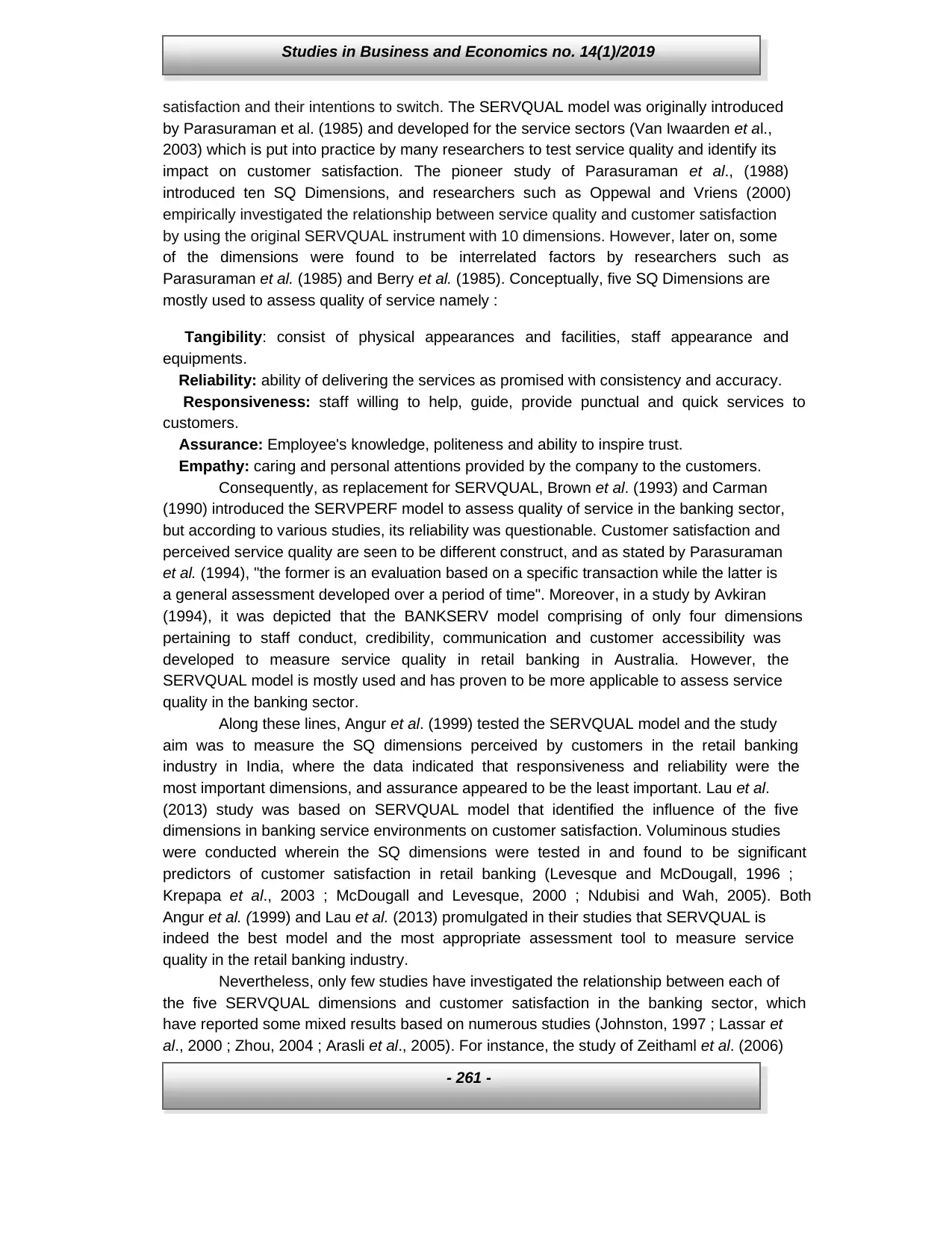
Studies in Business and Economics no. 14(1)/2019
- 261 -
satisfaction and their intentions to switch. The SERVQUAL model was originally introduced
by Parasuraman et al. (1985) and developed for the service sectors (Van Iwaarden et al.,
2003) which is put into practice by many researchers to test service quality and identify its
impact on customer satisfaction. The pioneer study of Parasuraman et al., (1988)
introduced ten SQ Dimensions, and researchers such as Oppewal and Vriens (2000)
empirically investigated the relationship between service quality and customer satisfaction
by using the original SERVQUAL instrument with 10 dimensions. However, later on, some
of the dimensions were found to be interrelated factors by researchers such as
Parasuraman et al. (1985) and Berry et al. (1985). Conceptually, five SQ Dimensions are
mostly used to assess quality of service namely :
Tangibility: consist of physical appearances and facilities, staff appearance and
equipments.
Reliability: ability of delivering the services as promised with consistency and accuracy.
Responsiveness: staff willing to help, guide, provide punctual and quick services to
customers.
Assurance: Employee's knowledge, politeness and ability to inspire trust.
Empathy: caring and personal attentions provided by the company to the customers.
Consequently, as replacement for SERVQUAL, Brown et al. (1993) and Carman
(1990) introduced the SERVPERF model to assess quality of service in the banking sector,
but according to various studies, its reliability was questionable. Customer satisfaction and
perceived service quality are seen to be different construct, and as stated by Parasuraman
et al. (1994), "the former is an evaluation based on a specific transaction while the latter is
a general assessment developed over a period of time". Moreover, in a study by Avkiran
(1994), it was depicted that the BANKSERV model comprising of only four dimensions
pertaining to staff conduct, credibility, communication and customer accessibility was
developed to measure service quality in retail banking in Australia. However, the
SERVQUAL model is mostly used and has proven to be more applicable to assess service
quality in the banking sector.
Along these lines, Angur et al. (1999) tested the SERVQUAL model and the study
aim was to measure the SQ dimensions perceived by customers in the retail banking
industry in India, where the data indicated that responsiveness and reliability were the
most important dimensions, and assurance appeared to be the least important. Lau et al.
(2013) study was based on SERVQUAL model that identified the influence of the five
dimensions in banking service environments on customer satisfaction. Voluminous studies
were conducted wherein the SQ dimensions were tested in and found to be significant
predictors of customer satisfaction in retail banking (Levesque and McDougall, 1996 ;
Krepapa et al., 2003 ; McDougall and Levesque, 2000 ; Ndubisi and Wah, 2005). Both
Angur et al. (1999) and Lau et al. (2013) promulgated in their studies that SERVQUAL is
indeed the best model and the most appropriate assessment tool to measure service
quality in the retail banking industry.
Nevertheless, only few studies have investigated the relationship between each of
the five SERVQUAL dimensions and customer satisfaction in the banking sector, which
have reported some mixed results based on numerous studies (Johnston, 1997 ; Lassar et
al., 2000 ; Zhou, 2004 ; Arasli et al., 2005). For instance, the study of Zeithaml et al. (2006)
- 261 -
satisfaction and their intentions to switch. The SERVQUAL model was originally introduced
by Parasuraman et al. (1985) and developed for the service sectors (Van Iwaarden et al.,
2003) which is put into practice by many researchers to test service quality and identify its
impact on customer satisfaction. The pioneer study of Parasuraman et al., (1988)
introduced ten SQ Dimensions, and researchers such as Oppewal and Vriens (2000)
empirically investigated the relationship between service quality and customer satisfaction
by using the original SERVQUAL instrument with 10 dimensions. However, later on, some
of the dimensions were found to be interrelated factors by researchers such as
Parasuraman et al. (1985) and Berry et al. (1985). Conceptually, five SQ Dimensions are
mostly used to assess quality of service namely :
Tangibility: consist of physical appearances and facilities, staff appearance and
equipments.
Reliability: ability of delivering the services as promised with consistency and accuracy.
Responsiveness: staff willing to help, guide, provide punctual and quick services to
customers.
Assurance: Employee's knowledge, politeness and ability to inspire trust.
Empathy: caring and personal attentions provided by the company to the customers.
Consequently, as replacement for SERVQUAL, Brown et al. (1993) and Carman
(1990) introduced the SERVPERF model to assess quality of service in the banking sector,
but according to various studies, its reliability was questionable. Customer satisfaction and
perceived service quality are seen to be different construct, and as stated by Parasuraman
et al. (1994), "the former is an evaluation based on a specific transaction while the latter is
a general assessment developed over a period of time". Moreover, in a study by Avkiran
(1994), it was depicted that the BANKSERV model comprising of only four dimensions
pertaining to staff conduct, credibility, communication and customer accessibility was
developed to measure service quality in retail banking in Australia. However, the
SERVQUAL model is mostly used and has proven to be more applicable to assess service
quality in the banking sector.
Along these lines, Angur et al. (1999) tested the SERVQUAL model and the study
aim was to measure the SQ dimensions perceived by customers in the retail banking
industry in India, where the data indicated that responsiveness and reliability were the
most important dimensions, and assurance appeared to be the least important. Lau et al.
(2013) study was based on SERVQUAL model that identified the influence of the five
dimensions in banking service environments on customer satisfaction. Voluminous studies
were conducted wherein the SQ dimensions were tested in and found to be significant
predictors of customer satisfaction in retail banking (Levesque and McDougall, 1996 ;
Krepapa et al., 2003 ; McDougall and Levesque, 2000 ; Ndubisi and Wah, 2005). Both
Angur et al. (1999) and Lau et al. (2013) promulgated in their studies that SERVQUAL is
indeed the best model and the most appropriate assessment tool to measure service
quality in the retail banking industry.
Nevertheless, only few studies have investigated the relationship between each of
the five SERVQUAL dimensions and customer satisfaction in the banking sector, which
have reported some mixed results based on numerous studies (Johnston, 1997 ; Lassar et
al., 2000 ; Zhou, 2004 ; Arasli et al., 2005). For instance, the study of Zeithaml et al. (2006)
⊘ This is a preview!⊘
Do you want full access?
Subscribe today to unlock all pages.

Trusted by 1+ million students worldwide
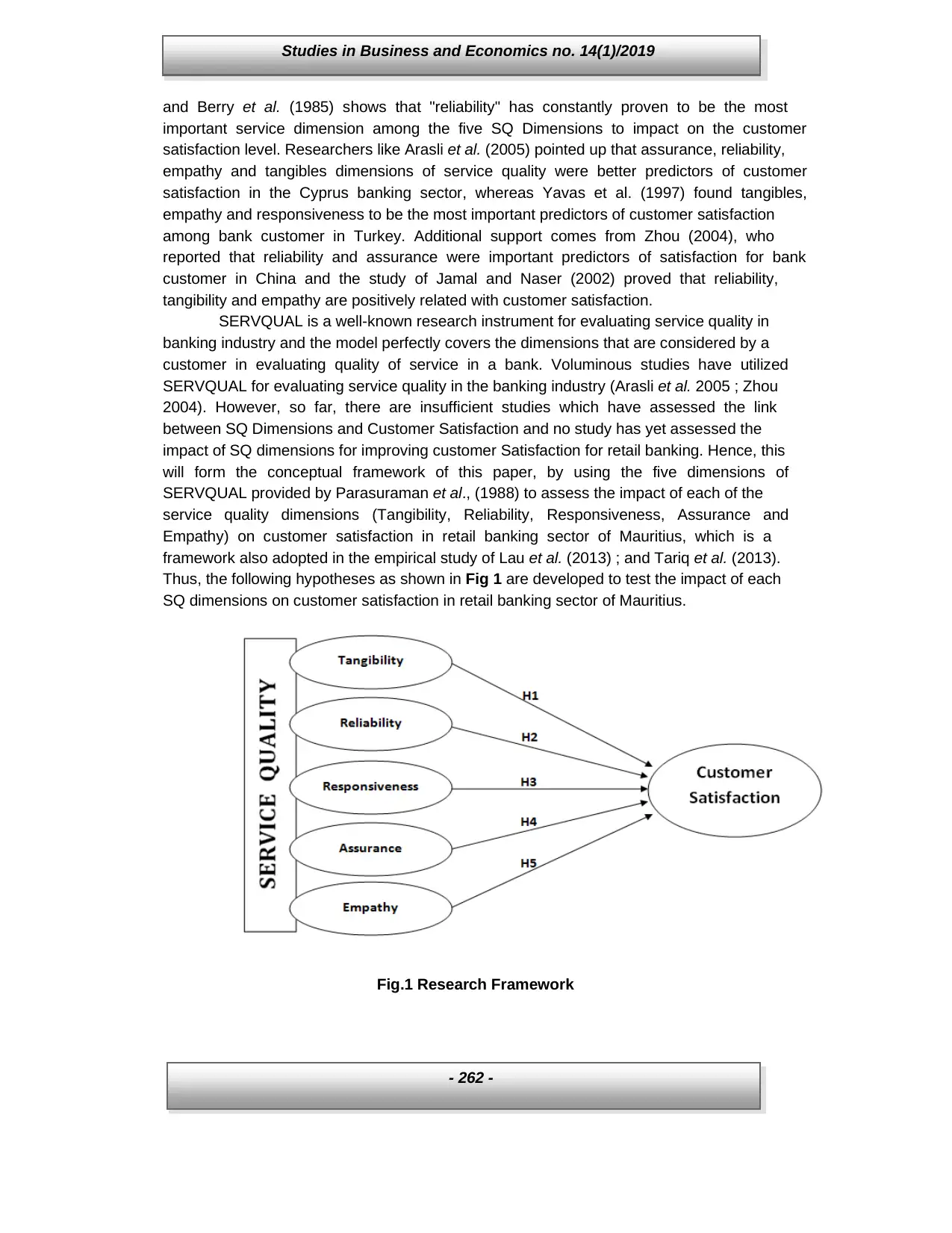
Studies in Business and Economics no. 14(1)/2019
- 262 -
and Berry et al. (1985) shows that "reliability" has constantly proven to be the most
important service dimension among the five SQ Dimensions to impact on the customer
satisfaction level. Researchers like Arasli et al. (2005) pointed up that assurance, reliability,
empathy and tangibles dimensions of service quality were better predictors of customer
satisfaction in the Cyprus banking sector, whereas Yavas et al. (1997) found tangibles,
empathy and responsiveness to be the most important predictors of customer satisfaction
among bank customer in Turkey. Additional support comes from Zhou (2004), who
reported that reliability and assurance were important predictors of satisfaction for bank
customer in China and the study of Jamal and Naser (2002) proved that reliability,
tangibility and empathy are positively related with customer satisfaction.
SERVQUAL is a well-known research instrument for evaluating service quality in
banking industry and the model perfectly covers the dimensions that are considered by a
customer in evaluating quality of service in a bank. Voluminous studies have utilized
SERVQUAL for evaluating service quality in the banking industry (Arasli et al. 2005 ; Zhou
2004). However, so far, there are insufficient studies which have assessed the link
between SQ Dimensions and Customer Satisfaction and no study has yet assessed the
impact of SQ dimensions for improving customer Satisfaction for retail banking. Hence, this
will form the conceptual framework of this paper, by using the five dimensions of
SERVQUAL provided by Parasuraman et al., (1988) to assess the impact of each of the
service quality dimensions (Tangibility, Reliability, Responsiveness, Assurance and
Empathy) on customer satisfaction in retail banking sector of Mauritius, which is a
framework also adopted in the empirical study of Lau et al. (2013) ; and Tariq et al. (2013).
Thus, the following hypotheses as shown in Fig 1 are developed to test the impact of each
SQ dimensions on customer satisfaction in retail banking sector of Mauritius.
Fig.1 Research Framework
- 262 -
and Berry et al. (1985) shows that "reliability" has constantly proven to be the most
important service dimension among the five SQ Dimensions to impact on the customer
satisfaction level. Researchers like Arasli et al. (2005) pointed up that assurance, reliability,
empathy and tangibles dimensions of service quality were better predictors of customer
satisfaction in the Cyprus banking sector, whereas Yavas et al. (1997) found tangibles,
empathy and responsiveness to be the most important predictors of customer satisfaction
among bank customer in Turkey. Additional support comes from Zhou (2004), who
reported that reliability and assurance were important predictors of satisfaction for bank
customer in China and the study of Jamal and Naser (2002) proved that reliability,
tangibility and empathy are positively related with customer satisfaction.
SERVQUAL is a well-known research instrument for evaluating service quality in
banking industry and the model perfectly covers the dimensions that are considered by a
customer in evaluating quality of service in a bank. Voluminous studies have utilized
SERVQUAL for evaluating service quality in the banking industry (Arasli et al. 2005 ; Zhou
2004). However, so far, there are insufficient studies which have assessed the link
between SQ Dimensions and Customer Satisfaction and no study has yet assessed the
impact of SQ dimensions for improving customer Satisfaction for retail banking. Hence, this
will form the conceptual framework of this paper, by using the five dimensions of
SERVQUAL provided by Parasuraman et al., (1988) to assess the impact of each of the
service quality dimensions (Tangibility, Reliability, Responsiveness, Assurance and
Empathy) on customer satisfaction in retail banking sector of Mauritius, which is a
framework also adopted in the empirical study of Lau et al. (2013) ; and Tariq et al. (2013).
Thus, the following hypotheses as shown in Fig 1 are developed to test the impact of each
SQ dimensions on customer satisfaction in retail banking sector of Mauritius.
Fig.1 Research Framework
Paraphrase This Document
Need a fresh take? Get an instant paraphrase of this document with our AI Paraphraser
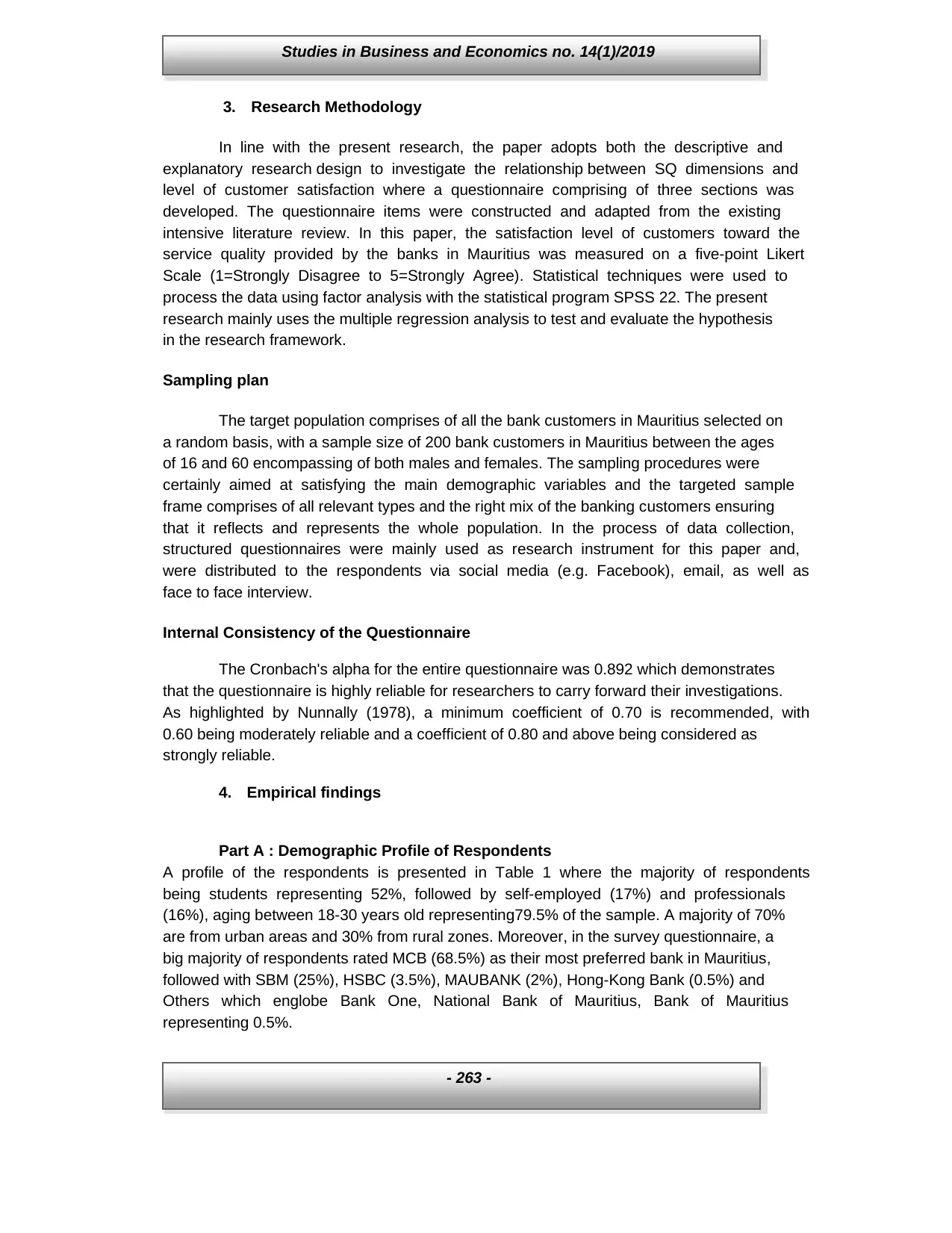
Studies in Business and Economics no. 14(1)/2019
- 263 -
3. Research Methodology
In line with the present research, the paper adopts both the descriptive and
explanatory research design to investigate the relationship between SQ dimensions and
level of customer satisfaction where a questionnaire comprising of three sections was
developed. The questionnaire items were constructed and adapted from the existing
intensive literature review. In this paper, the satisfaction level of customers toward the
service quality provided by the banks in Mauritius was measured on a five-point Likert
Scale (1=Strongly Disagree to 5=Strongly Agree). Statistical techniques were used to
process the data using factor analysis with the statistical program SPSS 22. The present
research mainly uses the multiple regression analysis to test and evaluate the hypothesis
in the research framework.
Sampling plan
The target population comprises of all the bank customers in Mauritius selected on
a random basis, with a sample size of 200 bank customers in Mauritius between the ages
of 16 and 60 encompassing of both males and females. The sampling procedures were
certainly aimed at satisfying the main demographic variables and the targeted sample
frame comprises of all relevant types and the right mix of the banking customers ensuring
that it reflects and represents the whole population. In the process of data collection,
structured questionnaires were mainly used as research instrument for this paper and,
were distributed to the respondents via social media (e.g. Facebook), email, as well as
face to face interview.
Internal Consistency of the Questionnaire
The Cronbach's alpha for the entire questionnaire was 0.892 which demonstrates
that the questionnaire is highly reliable for researchers to carry forward their investigations.
As highlighted by Nunnally (1978), a minimum coefficient of 0.70 is recommended, with
0.60 being moderately reliable and a coefficient of 0.80 and above being considered as
strongly reliable.
4. Empirical findings
Part A : Demographic Profile of Respondents
A profile of the respondents is presented in Table 1 where the majority of respondents
being students representing 52%, followed by self-employed (17%) and professionals
(16%), aging between 18-30 years old representing79.5% of the sample. A majority of 70%
are from urban areas and 30% from rural zones. Moreover, in the survey questionnaire, a
big majority of respondents rated MCB (68.5%) as their most preferred bank in Mauritius,
followed with SBM (25%), HSBC (3.5%), MAUBANK (2%), Hong-Kong Bank (0.5%) and
Others which englobe Bank One, National Bank of Mauritius, Bank of Mauritius
representing 0.5%.
- 263 -
3. Research Methodology
In line with the present research, the paper adopts both the descriptive and
explanatory research design to investigate the relationship between SQ dimensions and
level of customer satisfaction where a questionnaire comprising of three sections was
developed. The questionnaire items were constructed and adapted from the existing
intensive literature review. In this paper, the satisfaction level of customers toward the
service quality provided by the banks in Mauritius was measured on a five-point Likert
Scale (1=Strongly Disagree to 5=Strongly Agree). Statistical techniques were used to
process the data using factor analysis with the statistical program SPSS 22. The present
research mainly uses the multiple regression analysis to test and evaluate the hypothesis
in the research framework.
Sampling plan
The target population comprises of all the bank customers in Mauritius selected on
a random basis, with a sample size of 200 bank customers in Mauritius between the ages
of 16 and 60 encompassing of both males and females. The sampling procedures were
certainly aimed at satisfying the main demographic variables and the targeted sample
frame comprises of all relevant types and the right mix of the banking customers ensuring
that it reflects and represents the whole population. In the process of data collection,
structured questionnaires were mainly used as research instrument for this paper and,
were distributed to the respondents via social media (e.g. Facebook), email, as well as
face to face interview.
Internal Consistency of the Questionnaire
The Cronbach's alpha for the entire questionnaire was 0.892 which demonstrates
that the questionnaire is highly reliable for researchers to carry forward their investigations.
As highlighted by Nunnally (1978), a minimum coefficient of 0.70 is recommended, with
0.60 being moderately reliable and a coefficient of 0.80 and above being considered as
strongly reliable.
4. Empirical findings
Part A : Demographic Profile of Respondents
A profile of the respondents is presented in Table 1 where the majority of respondents
being students representing 52%, followed by self-employed (17%) and professionals
(16%), aging between 18-30 years old representing79.5% of the sample. A majority of 70%
are from urban areas and 30% from rural zones. Moreover, in the survey questionnaire, a
big majority of respondents rated MCB (68.5%) as their most preferred bank in Mauritius,
followed with SBM (25%), HSBC (3.5%), MAUBANK (2%), Hong-Kong Bank (0.5%) and
Others which englobe Bank One, National Bank of Mauritius, Bank of Mauritius
representing 0.5%.
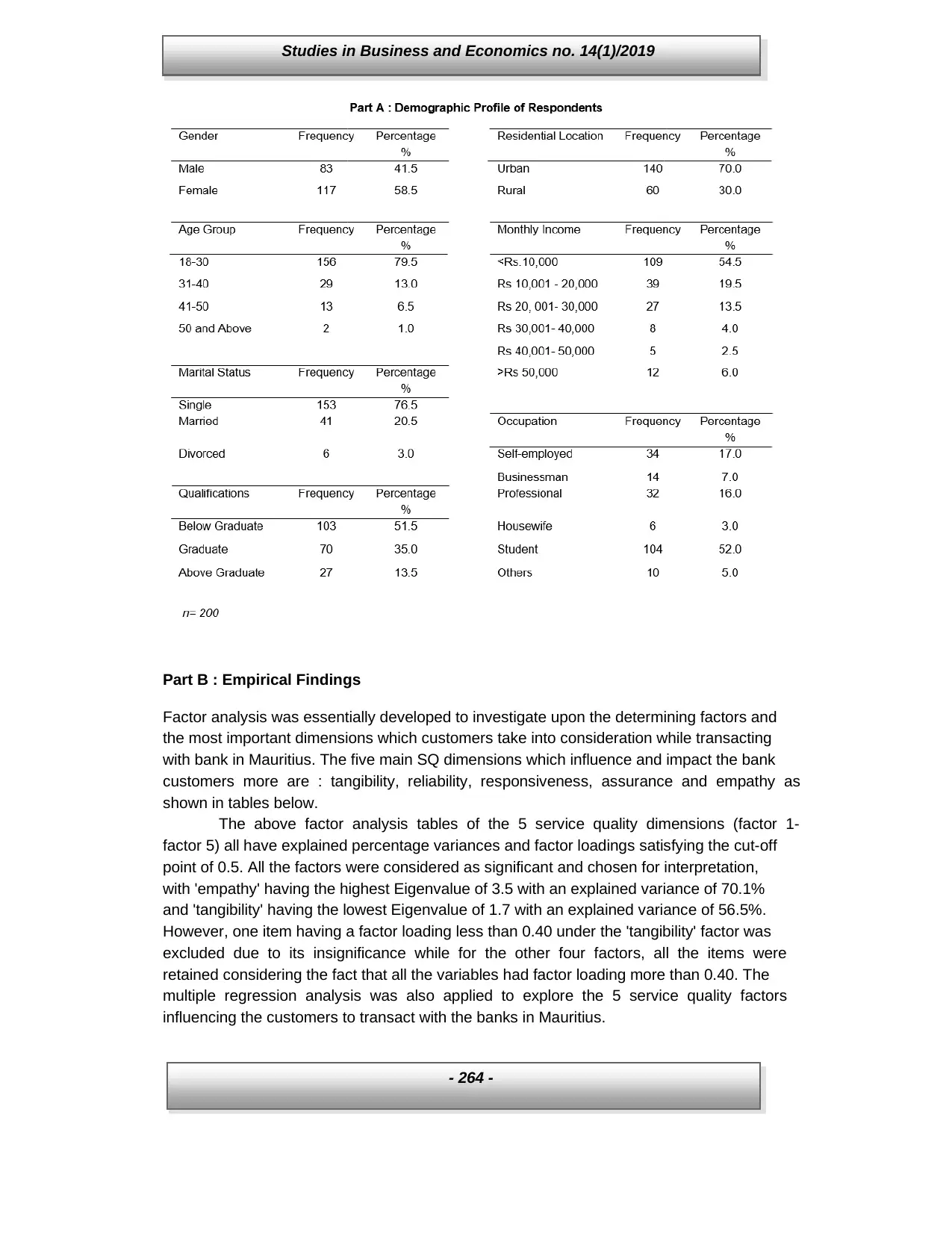
Studies in Business and Economics no. 14(1)/2019
- 264 -
Part B : Empirical Findings
Factor analysis was essentially developed to investigate upon the determining factors and
the most important dimensions which customers take into consideration while transacting
with bank in Mauritius. The five main SQ dimensions which influence and impact the bank
customers more are : tangibility, reliability, responsiveness, assurance and empathy as
shown in tables below.
The above factor analysis tables of the 5 service quality dimensions (factor 1-
factor 5) all have explained percentage variances and factor loadings satisfying the cut-off
point of 0.5. All the factors were considered as significant and chosen for interpretation,
with 'empathy' having the highest Eigenvalue of 3.5 with an explained variance of 70.1%
and 'tangibility' having the lowest Eigenvalue of 1.7 with an explained variance of 56.5%.
However, one item having a factor loading less than 0.40 under the 'tangibility' factor was
excluded due to its insignificance while for the other four factors, all the items were
retained considering the fact that all the variables had factor loading more than 0.40. The
multiple regression analysis was also applied to explore the 5 service quality factors
influencing the customers to transact with the banks in Mauritius.
- 264 -
Part B : Empirical Findings
Factor analysis was essentially developed to investigate upon the determining factors and
the most important dimensions which customers take into consideration while transacting
with bank in Mauritius. The five main SQ dimensions which influence and impact the bank
customers more are : tangibility, reliability, responsiveness, assurance and empathy as
shown in tables below.
The above factor analysis tables of the 5 service quality dimensions (factor 1-
factor 5) all have explained percentage variances and factor loadings satisfying the cut-off
point of 0.5. All the factors were considered as significant and chosen for interpretation,
with 'empathy' having the highest Eigenvalue of 3.5 with an explained variance of 70.1%
and 'tangibility' having the lowest Eigenvalue of 1.7 with an explained variance of 56.5%.
However, one item having a factor loading less than 0.40 under the 'tangibility' factor was
excluded due to its insignificance while for the other four factors, all the items were
retained considering the fact that all the variables had factor loading more than 0.40. The
multiple regression analysis was also applied to explore the 5 service quality factors
influencing the customers to transact with the banks in Mauritius.
⊘ This is a preview!⊘
Do you want full access?
Subscribe today to unlock all pages.

Trusted by 1+ million students worldwide
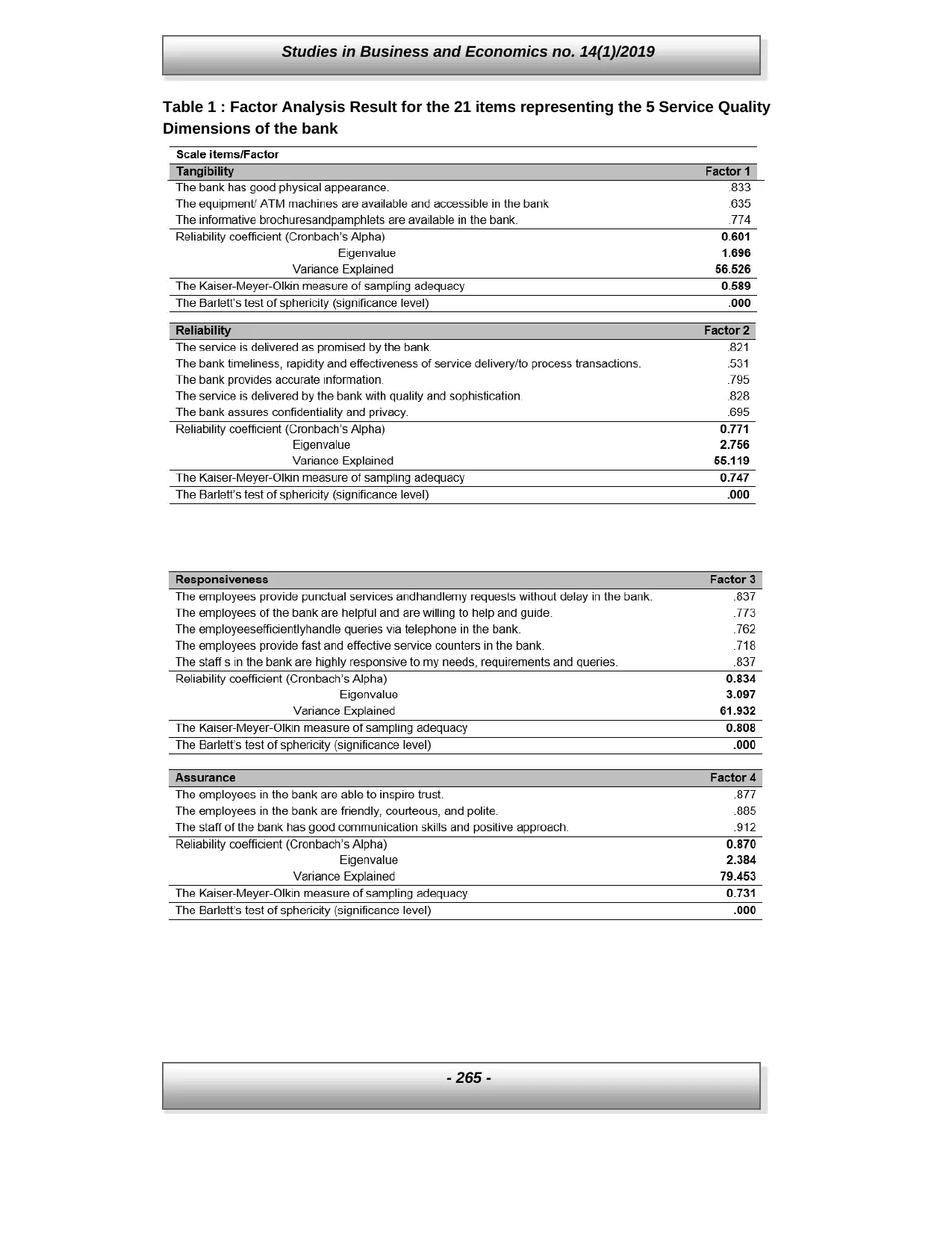
Studies in Business and Economics no. 14(1)/2019
- 265 -
Table 1 : Factor Analysis Result for the 21 items representing the 5 Service Quality
Dimensions of the bank
- 265 -
Table 1 : Factor Analysis Result for the 21 items representing the 5 Service Quality
Dimensions of the bank
Paraphrase This Document
Need a fresh take? Get an instant paraphrase of this document with our AI Paraphraser
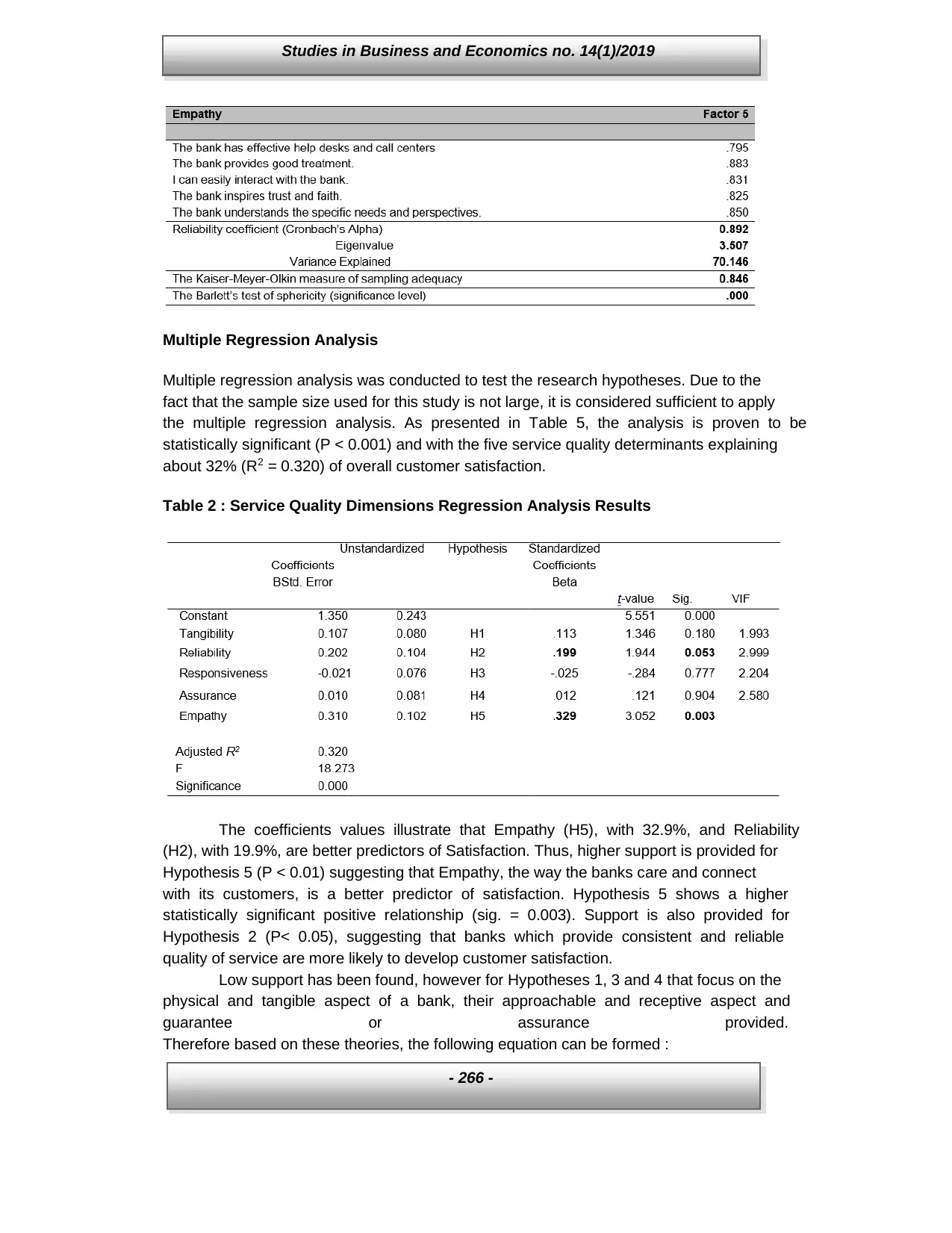
Studies in Business and Economics no. 14(1)/2019
- 266 -
Multiple Regression Analysis
Multiple regression analysis was conducted to test the research hypotheses. Due to the
fact that the sample size used for this study is not large, it is considered sufficient to apply
the multiple regression analysis. As presented in Table 5, the analysis is proven to be
statistically significant (P < 0.001) and with the five service quality determinants explaining
about 32% (R2 = 0.320) of overall customer satisfaction.
Table 2 : Service Quality Dimensions Regression Analysis Results
The coefficients values illustrate that Empathy (H5), with 32.9%, and Reliability
(H2), with 19.9%, are better predictors of Satisfaction. Thus, higher support is provided for
Hypothesis 5 (P < 0.01) suggesting that Empathy, the way the banks care and connect
with its customers, is a better predictor of satisfaction. Hypothesis 5 shows a higher
statistically significant positive relationship (sig. = 0.003). Support is also provided for
Hypothesis 2 (P< 0.05), suggesting that banks which provide consistent and reliable
quality of service are more likely to develop customer satisfaction.
Low support has been found, however for Hypotheses 1, 3 and 4 that focus on the
physical and tangible aspect of a bank, their approachable and receptive aspect and
guarantee or assurance provided.
Therefore based on these theories, the following equation can be formed :
- 266 -
Multiple Regression Analysis
Multiple regression analysis was conducted to test the research hypotheses. Due to the
fact that the sample size used for this study is not large, it is considered sufficient to apply
the multiple regression analysis. As presented in Table 5, the analysis is proven to be
statistically significant (P < 0.001) and with the five service quality determinants explaining
about 32% (R2 = 0.320) of overall customer satisfaction.
Table 2 : Service Quality Dimensions Regression Analysis Results
The coefficients values illustrate that Empathy (H5), with 32.9%, and Reliability
(H2), with 19.9%, are better predictors of Satisfaction. Thus, higher support is provided for
Hypothesis 5 (P < 0.01) suggesting that Empathy, the way the banks care and connect
with its customers, is a better predictor of satisfaction. Hypothesis 5 shows a higher
statistically significant positive relationship (sig. = 0.003). Support is also provided for
Hypothesis 2 (P< 0.05), suggesting that banks which provide consistent and reliable
quality of service are more likely to develop customer satisfaction.
Low support has been found, however for Hypotheses 1, 3 and 4 that focus on the
physical and tangible aspect of a bank, their approachable and receptive aspect and
guarantee or assurance provided.
Therefore based on these theories, the following equation can be formed :
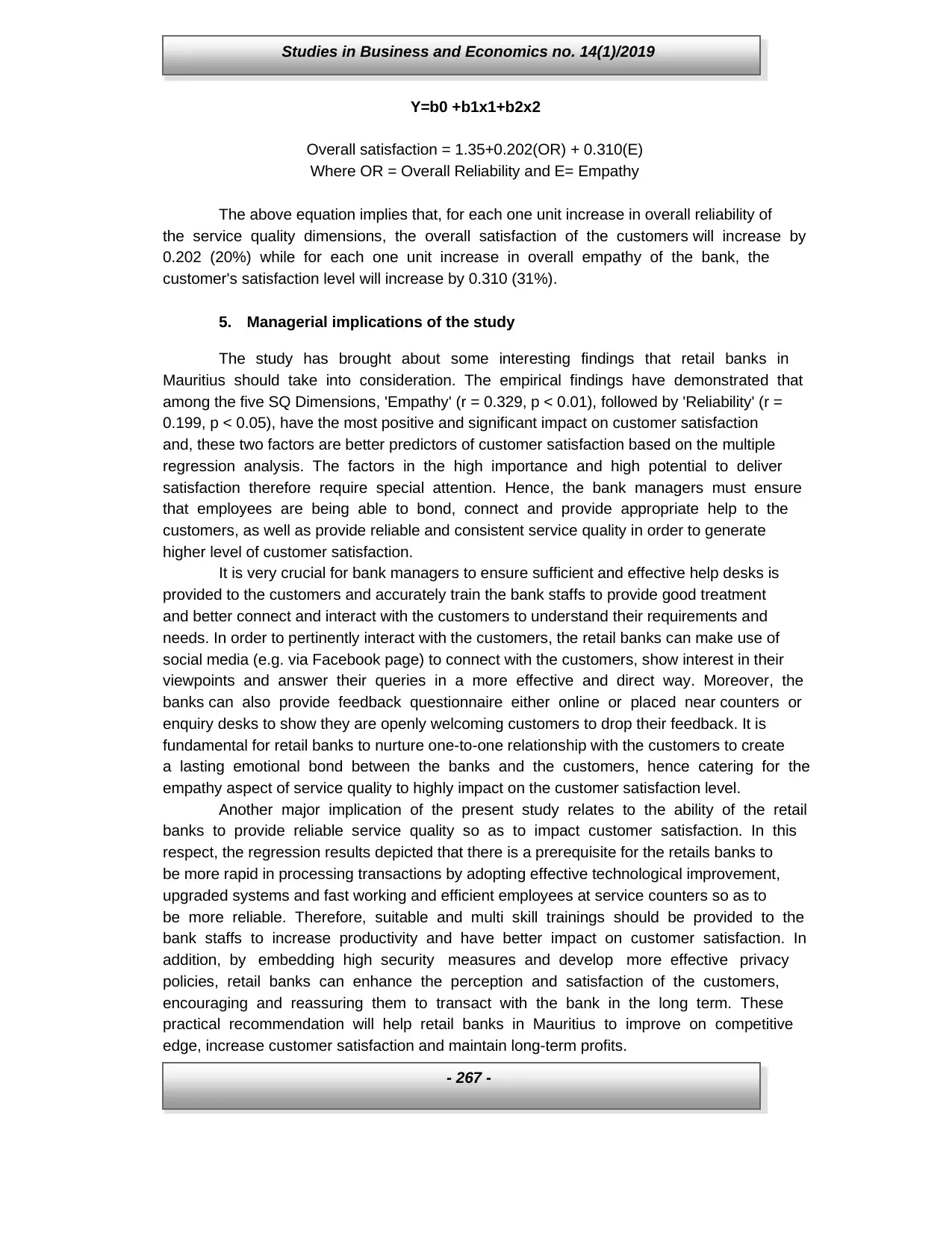
Studies in Business and Economics no. 14(1)/2019
- 267 -
Y=b0 +b1x1+b2x2
Overall satisfaction = 1.35+0.202(OR) + 0.310(E)
Where OR = Overall Reliability and E= Empathy
The above equation implies that, for each one unit increase in overall reliability of
the service quality dimensions, the overall satisfaction of the customers will increase by
0.202 (20%) while for each one unit increase in overall empathy of the bank, the
customer's satisfaction level will increase by 0.310 (31%).
5. Managerial implications of the study
The study has brought about some interesting findings that retail banks in
Mauritius should take into consideration. The empirical findings have demonstrated that
among the five SQ Dimensions, 'Empathy' (r = 0.329, p < 0.01), followed by 'Reliability' (r =
0.199, p < 0.05), have the most positive and significant impact on customer satisfaction
and, these two factors are better predictors of customer satisfaction based on the multiple
regression analysis. The factors in the high importance and high potential to deliver
satisfaction therefore require special attention. Hence, the bank managers must ensure
that employees are being able to bond, connect and provide appropriate help to the
customers, as well as provide reliable and consistent service quality in order to generate
higher level of customer satisfaction.
It is very crucial for bank managers to ensure sufficient and effective help desks is
provided to the customers and accurately train the bank staffs to provide good treatment
and better connect and interact with the customers to understand their requirements and
needs. In order to pertinently interact with the customers, the retail banks can make use of
social media (e.g. via Facebook page) to connect with the customers, show interest in their
viewpoints and answer their queries in a more effective and direct way. Moreover, the
banks can also provide feedback questionnaire either online or placed near counters or
enquiry desks to show they are openly welcoming customers to drop their feedback. It is
fundamental for retail banks to nurture one-to-one relationship with the customers to create
a lasting emotional bond between the banks and the customers, hence catering for the
empathy aspect of service quality to highly impact on the customer satisfaction level.
Another major implication of the present study relates to the ability of the retail
banks to provide reliable service quality so as to impact customer satisfaction. In this
respect, the regression results depicted that there is a prerequisite for the retails banks to
be more rapid in processing transactions by adopting effective technological improvement,
upgraded systems and fast working and efficient employees at service counters so as to
be more reliable. Therefore, suitable and multi skill trainings should be provided to the
bank staffs to increase productivity and have better impact on customer satisfaction. In
addition, by embedding high security measures and develop more effective privacy
policies, retail banks can enhance the perception and satisfaction of the customers,
encouraging and reassuring them to transact with the bank in the long term. These
practical recommendation will help retail banks in Mauritius to improve on competitive
edge, increase customer satisfaction and maintain long-term profits.
- 267 -
Y=b0 +b1x1+b2x2
Overall satisfaction = 1.35+0.202(OR) + 0.310(E)
Where OR = Overall Reliability and E= Empathy
The above equation implies that, for each one unit increase in overall reliability of
the service quality dimensions, the overall satisfaction of the customers will increase by
0.202 (20%) while for each one unit increase in overall empathy of the bank, the
customer's satisfaction level will increase by 0.310 (31%).
5. Managerial implications of the study
The study has brought about some interesting findings that retail banks in
Mauritius should take into consideration. The empirical findings have demonstrated that
among the five SQ Dimensions, 'Empathy' (r = 0.329, p < 0.01), followed by 'Reliability' (r =
0.199, p < 0.05), have the most positive and significant impact on customer satisfaction
and, these two factors are better predictors of customer satisfaction based on the multiple
regression analysis. The factors in the high importance and high potential to deliver
satisfaction therefore require special attention. Hence, the bank managers must ensure
that employees are being able to bond, connect and provide appropriate help to the
customers, as well as provide reliable and consistent service quality in order to generate
higher level of customer satisfaction.
It is very crucial for bank managers to ensure sufficient and effective help desks is
provided to the customers and accurately train the bank staffs to provide good treatment
and better connect and interact with the customers to understand their requirements and
needs. In order to pertinently interact with the customers, the retail banks can make use of
social media (e.g. via Facebook page) to connect with the customers, show interest in their
viewpoints and answer their queries in a more effective and direct way. Moreover, the
banks can also provide feedback questionnaire either online or placed near counters or
enquiry desks to show they are openly welcoming customers to drop their feedback. It is
fundamental for retail banks to nurture one-to-one relationship with the customers to create
a lasting emotional bond between the banks and the customers, hence catering for the
empathy aspect of service quality to highly impact on the customer satisfaction level.
Another major implication of the present study relates to the ability of the retail
banks to provide reliable service quality so as to impact customer satisfaction. In this
respect, the regression results depicted that there is a prerequisite for the retails banks to
be more rapid in processing transactions by adopting effective technological improvement,
upgraded systems and fast working and efficient employees at service counters so as to
be more reliable. Therefore, suitable and multi skill trainings should be provided to the
bank staffs to increase productivity and have better impact on customer satisfaction. In
addition, by embedding high security measures and develop more effective privacy
policies, retail banks can enhance the perception and satisfaction of the customers,
encouraging and reassuring them to transact with the bank in the long term. These
practical recommendation will help retail banks in Mauritius to improve on competitive
edge, increase customer satisfaction and maintain long-term profits.
⊘ This is a preview!⊘
Do you want full access?
Subscribe today to unlock all pages.

Trusted by 1+ million students worldwide
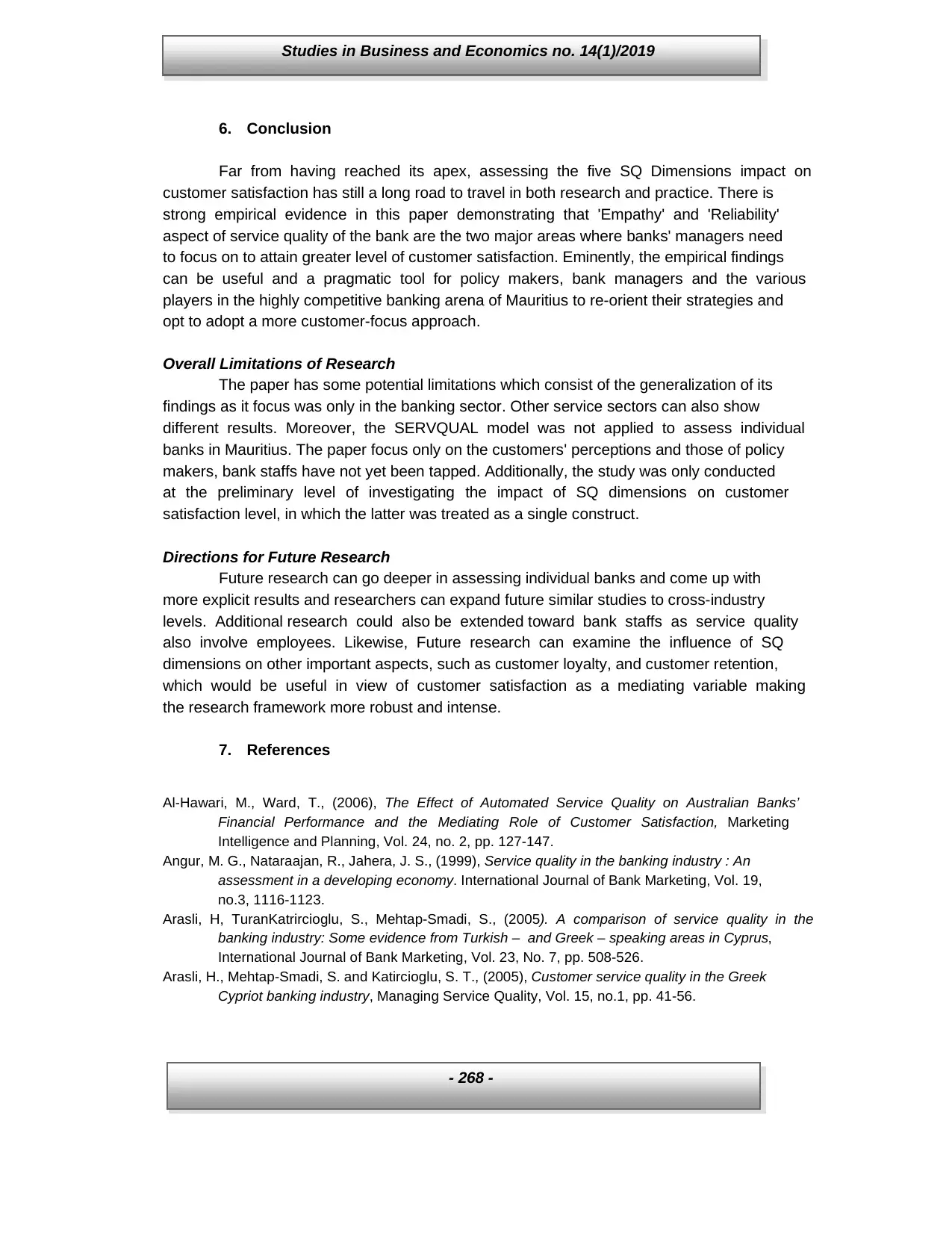
Studies in Business and Economics no. 14(1)/2019
- 268 -
6. Conclusion
Far from having reached its apex, assessing the five SQ Dimensions impact on
customer satisfaction has still a long road to travel in both research and practice. There is
strong empirical evidence in this paper demonstrating that 'Empathy' and 'Reliability'
aspect of service quality of the bank are the two major areas where banks' managers need
to focus on to attain greater level of customer satisfaction. Eminently, the empirical findings
can be useful and a pragmatic tool for policy makers, bank managers and the various
players in the highly competitive banking arena of Mauritius to re-orient their strategies and
opt to adopt a more customer-focus approach.
Overall Limitations of Research
The paper has some potential limitations which consist of the generalization of its
findings as it focus was only in the banking sector. Other service sectors can also show
different results. Moreover, the SERVQUAL model was not applied to assess individual
banks in Mauritius. The paper focus only on the customers' perceptions and those of policy
makers, bank staffs have not yet been tapped. Additionally, the study was only conducted
at the preliminary level of investigating the impact of SQ dimensions on customer
satisfaction level, in which the latter was treated as a single construct.
Directions for Future Research
Future research can go deeper in assessing individual banks and come up with
more explicit results and researchers can expand future similar studies to cross-industry
levels. Additional research could also be extended toward bank staffs as service quality
also involve employees. Likewise, Future research can examine the influence of SQ
dimensions on other important aspects, such as customer loyalty, and customer retention,
which would be useful in view of customer satisfaction as a mediating variable making
the research framework more robust and intense.
7. References
Al-Hawari, M., Ward, T., (2006), The Effect of Automated Service Quality on Australian Banks’
Financial Performance and the Mediating Role of Customer Satisfaction, Marketing
Intelligence and Planning, Vol. 24, no. 2, pp. 127-147.
Angur, M. G., Nataraajan, R., Jahera, J. S., (1999), Service quality in the banking industry : An
assessment in a developing economy. International Journal of Bank Marketing, Vol. 19,
no.3, 1116-1123.
Arasli, H, TuranKatrircioglu, S., Mehtap-Smadi, S., (2005). A comparison of service quality in the
banking industry: Some evidence from Turkish – and Greek – speaking areas in Cyprus,
International Journal of Bank Marketing, Vol. 23, No. 7, pp. 508-526.
Arasli, H., Mehtap-Smadi, S. and Katircioglu, S. T., (2005), Customer service quality in the Greek
Cypriot banking industry, Managing Service Quality, Vol. 15, no.1, pp. 41-56.
- 268 -
6. Conclusion
Far from having reached its apex, assessing the five SQ Dimensions impact on
customer satisfaction has still a long road to travel in both research and practice. There is
strong empirical evidence in this paper demonstrating that 'Empathy' and 'Reliability'
aspect of service quality of the bank are the two major areas where banks' managers need
to focus on to attain greater level of customer satisfaction. Eminently, the empirical findings
can be useful and a pragmatic tool for policy makers, bank managers and the various
players in the highly competitive banking arena of Mauritius to re-orient their strategies and
opt to adopt a more customer-focus approach.
Overall Limitations of Research
The paper has some potential limitations which consist of the generalization of its
findings as it focus was only in the banking sector. Other service sectors can also show
different results. Moreover, the SERVQUAL model was not applied to assess individual
banks in Mauritius. The paper focus only on the customers' perceptions and those of policy
makers, bank staffs have not yet been tapped. Additionally, the study was only conducted
at the preliminary level of investigating the impact of SQ dimensions on customer
satisfaction level, in which the latter was treated as a single construct.
Directions for Future Research
Future research can go deeper in assessing individual banks and come up with
more explicit results and researchers can expand future similar studies to cross-industry
levels. Additional research could also be extended toward bank staffs as service quality
also involve employees. Likewise, Future research can examine the influence of SQ
dimensions on other important aspects, such as customer loyalty, and customer retention,
which would be useful in view of customer satisfaction as a mediating variable making
the research framework more robust and intense.
7. References
Al-Hawari, M., Ward, T., (2006), The Effect of Automated Service Quality on Australian Banks’
Financial Performance and the Mediating Role of Customer Satisfaction, Marketing
Intelligence and Planning, Vol. 24, no. 2, pp. 127-147.
Angur, M. G., Nataraajan, R., Jahera, J. S., (1999), Service quality in the banking industry : An
assessment in a developing economy. International Journal of Bank Marketing, Vol. 19,
no.3, 1116-1123.
Arasli, H, TuranKatrircioglu, S., Mehtap-Smadi, S., (2005). A comparison of service quality in the
banking industry: Some evidence from Turkish – and Greek – speaking areas in Cyprus,
International Journal of Bank Marketing, Vol. 23, No. 7, pp. 508-526.
Arasli, H., Mehtap-Smadi, S. and Katircioglu, S. T., (2005), Customer service quality in the Greek
Cypriot banking industry, Managing Service Quality, Vol. 15, no.1, pp. 41-56.
Paraphrase This Document
Need a fresh take? Get an instant paraphrase of this document with our AI Paraphraser
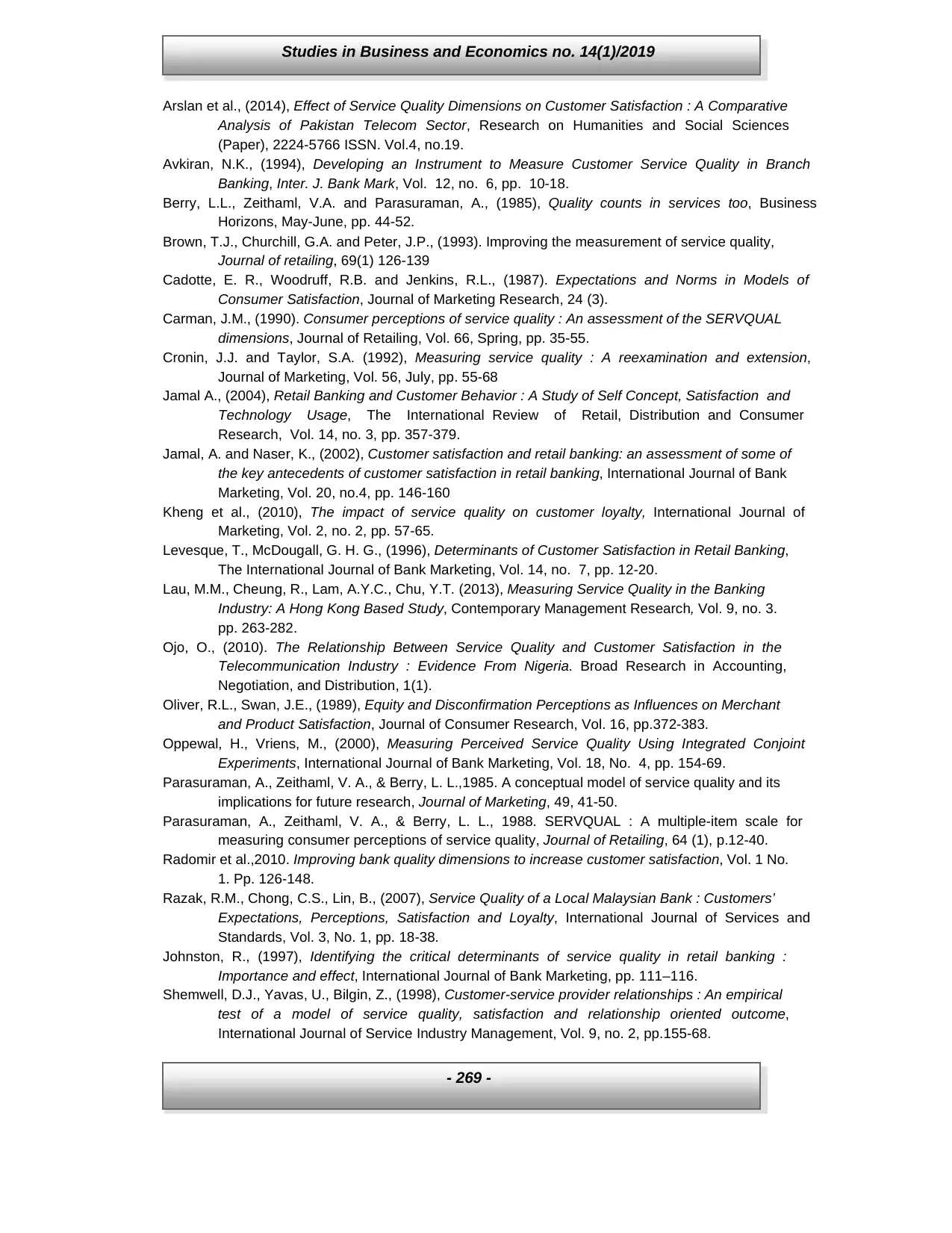
Studies in Business and Economics no. 14(1)/2019
- 269 -
Arslan et al., (2014), Effect of Service Quality Dimensions on Customer Satisfaction : A Comparative
Analysis of Pakistan Telecom Sector, Research on Humanities and Social Sciences
(Paper), 2224-5766 ISSN. Vol.4, no.19.
Avkiran, N.K., (1994), Developing an Instrument to Measure Customer Service Quality in Branch
Banking, Inter. J. Bank Mark, Vol. 12, no. 6, pp. 10-18.
Berry, L.L., Zeithaml, V.A. and Parasuraman, A., (1985), Quality counts in services too, Business
Horizons, May-June, pp. 44-52.
Brown, T.J., Churchill, G.A. and Peter, J.P., (1993). Improving the measurement of service quality,
Journal of retailing, 69(1) 126-139
Cadotte, E. R., Woodruff, R.B. and Jenkins, R.L., (1987). Expectations and Norms in Models of
Consumer Satisfaction, Journal of Marketing Research, 24 (3).
Carman, J.M., (1990). Consumer perceptions of service quality : An assessment of the SERVQUAL
dimensions, Journal of Retailing, Vol. 66, Spring, pp. 35-55.
Cronin, J.J. and Taylor, S.A. (1992), Measuring service quality : A reexamination and extension,
Journal of Marketing, Vol. 56, July, pp. 55-68
Jamal A., (2004), Retail Banking and Customer Behavior : A Study of Self Concept, Satisfaction and
Technology Usage, The International Review of Retail, Distribution and Consumer
Research, Vol. 14, no. 3, pp. 357-379.
Jamal, A. and Naser, K., (2002), Customer satisfaction and retail banking: an assessment of some of
the key antecedents of customer satisfaction in retail banking, International Journal of Bank
Marketing, Vol. 20, no.4, pp. 146-160
Kheng et al., (2010), The impact of service quality on customer loyalty, International Journal of
Marketing, Vol. 2, no. 2, pp. 57-65.
Levesque, T., McDougall, G. H. G., (1996), Determinants of Customer Satisfaction in Retail Banking,
The International Journal of Bank Marketing, Vol. 14, no. 7, pp. 12-20.
Lau, M.M., Cheung, R., Lam, A.Y.C., Chu, Y.T. (2013), Measuring Service Quality in the Banking
Industry: A Hong Kong Based Study, Contemporary Management Research, Vol. 9, no. 3.
pp. 263-282.
Ojo, O., (2010). The Relationship Between Service Quality and Customer Satisfaction in the
Telecommunication Industry : Evidence From Nigeria. Broad Research in Accounting,
Negotiation, and Distribution, 1(1).
Oliver, R.L., Swan, J.E., (1989), Equity and Disconfirmation Perceptions as Influences on Merchant
and Product Satisfaction, Journal of Consumer Research, Vol. 16, pp.372-383.
Oppewal, H., Vriens, M., (2000), Measuring Perceived Service Quality Using Integrated Conjoint
Experiments, International Journal of Bank Marketing, Vol. 18, No. 4, pp. 154-69.
Parasuraman, A., Zeithaml, V. A., & Berry, L. L.,1985. A conceptual model of service quality and its
implications for future research, Journal of Marketing, 49, 41-50.
Parasuraman, A., Zeithaml, V. A., & Berry, L. L., 1988. SERVQUAL : A multiple-item scale for
measuring consumer perceptions of service quality, Journal of Retailing, 64 (1), p.12-40.
Radomir et al.,2010. Improving bank quality dimensions to increase customer satisfaction, Vol. 1 No.
1. Pp. 126-148.
Razak, R.M., Chong, C.S., Lin, B., (2007), Service Quality of a Local Malaysian Bank : Customers’
Expectations, Perceptions, Satisfaction and Loyalty, International Journal of Services and
Standards, Vol. 3, No. 1, pp. 18-38.
Johnston, R., (1997), Identifying the critical determinants of service quality in retail banking :
Importance and effect, International Journal of Bank Marketing, pp. 111–116.
Shemwell, D.J., Yavas, U., Bilgin, Z., (1998), Customer-service provider relationships : An empirical
test of a model of service quality, satisfaction and relationship oriented outcome,
International Journal of Service Industry Management, Vol. 9, no. 2, pp.155-68.
- 269 -
Arslan et al., (2014), Effect of Service Quality Dimensions on Customer Satisfaction : A Comparative
Analysis of Pakistan Telecom Sector, Research on Humanities and Social Sciences
(Paper), 2224-5766 ISSN. Vol.4, no.19.
Avkiran, N.K., (1994), Developing an Instrument to Measure Customer Service Quality in Branch
Banking, Inter. J. Bank Mark, Vol. 12, no. 6, pp. 10-18.
Berry, L.L., Zeithaml, V.A. and Parasuraman, A., (1985), Quality counts in services too, Business
Horizons, May-June, pp. 44-52.
Brown, T.J., Churchill, G.A. and Peter, J.P., (1993). Improving the measurement of service quality,
Journal of retailing, 69(1) 126-139
Cadotte, E. R., Woodruff, R.B. and Jenkins, R.L., (1987). Expectations and Norms in Models of
Consumer Satisfaction, Journal of Marketing Research, 24 (3).
Carman, J.M., (1990). Consumer perceptions of service quality : An assessment of the SERVQUAL
dimensions, Journal of Retailing, Vol. 66, Spring, pp. 35-55.
Cronin, J.J. and Taylor, S.A. (1992), Measuring service quality : A reexamination and extension,
Journal of Marketing, Vol. 56, July, pp. 55-68
Jamal A., (2004), Retail Banking and Customer Behavior : A Study of Self Concept, Satisfaction and
Technology Usage, The International Review of Retail, Distribution and Consumer
Research, Vol. 14, no. 3, pp. 357-379.
Jamal, A. and Naser, K., (2002), Customer satisfaction and retail banking: an assessment of some of
the key antecedents of customer satisfaction in retail banking, International Journal of Bank
Marketing, Vol. 20, no.4, pp. 146-160
Kheng et al., (2010), The impact of service quality on customer loyalty, International Journal of
Marketing, Vol. 2, no. 2, pp. 57-65.
Levesque, T., McDougall, G. H. G., (1996), Determinants of Customer Satisfaction in Retail Banking,
The International Journal of Bank Marketing, Vol. 14, no. 7, pp. 12-20.
Lau, M.M., Cheung, R., Lam, A.Y.C., Chu, Y.T. (2013), Measuring Service Quality in the Banking
Industry: A Hong Kong Based Study, Contemporary Management Research, Vol. 9, no. 3.
pp. 263-282.
Ojo, O., (2010). The Relationship Between Service Quality and Customer Satisfaction in the
Telecommunication Industry : Evidence From Nigeria. Broad Research in Accounting,
Negotiation, and Distribution, 1(1).
Oliver, R.L., Swan, J.E., (1989), Equity and Disconfirmation Perceptions as Influences on Merchant
and Product Satisfaction, Journal of Consumer Research, Vol. 16, pp.372-383.
Oppewal, H., Vriens, M., (2000), Measuring Perceived Service Quality Using Integrated Conjoint
Experiments, International Journal of Bank Marketing, Vol. 18, No. 4, pp. 154-69.
Parasuraman, A., Zeithaml, V. A., & Berry, L. L.,1985. A conceptual model of service quality and its
implications for future research, Journal of Marketing, 49, 41-50.
Parasuraman, A., Zeithaml, V. A., & Berry, L. L., 1988. SERVQUAL : A multiple-item scale for
measuring consumer perceptions of service quality, Journal of Retailing, 64 (1), p.12-40.
Radomir et al.,2010. Improving bank quality dimensions to increase customer satisfaction, Vol. 1 No.
1. Pp. 126-148.
Razak, R.M., Chong, C.S., Lin, B., (2007), Service Quality of a Local Malaysian Bank : Customers’
Expectations, Perceptions, Satisfaction and Loyalty, International Journal of Services and
Standards, Vol. 3, No. 1, pp. 18-38.
Johnston, R., (1997), Identifying the critical determinants of service quality in retail banking :
Importance and effect, International Journal of Bank Marketing, pp. 111–116.
Shemwell, D.J., Yavas, U., Bilgin, Z., (1998), Customer-service provider relationships : An empirical
test of a model of service quality, satisfaction and relationship oriented outcome,
International Journal of Service Industry Management, Vol. 9, no. 2, pp.155-68.
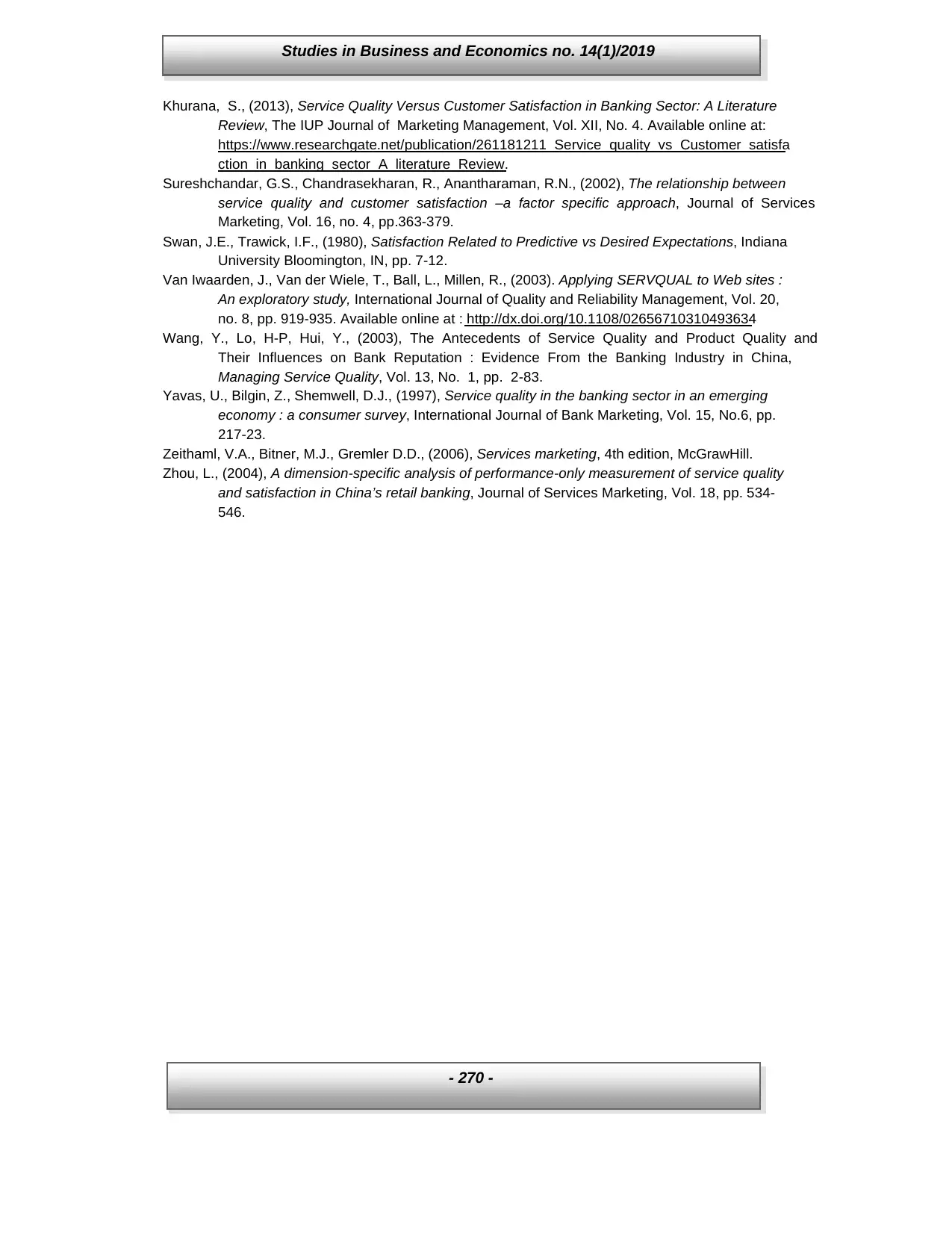
Studies in Business and Economics no. 14(1)/2019
- 270 -
Khurana, S., (2013), Service Quality Versus Customer Satisfaction in Banking Sector: A Literature
Review, The IUP Journal of Marketing Management, Vol. XII, No. 4. Available online at:
https://www.researchgate.net/publication/261181211_Service_quality_vs_Customer_satisfa
ction_in_banking_sector_A_literature_Review.
Sureshchandar, G.S., Chandrasekharan, R., Anantharaman, R.N., (2002), The relationship between
service quality and customer satisfaction –a factor specific approach, Journal of Services
Marketing, Vol. 16, no. 4, pp.363-379.
Swan, J.E., Trawick, I.F., (1980), Satisfaction Related to Predictive vs Desired Expectations, Indiana
University Bloomington, IN, pp. 7-12.
Van Iwaarden, J., Van der Wiele, T., Ball, L., Millen, R., (2003). Applying SERVQUAL to Web sites :
An exploratory study, International Journal of Quality and Reliability Management, Vol. 20,
no. 8, pp. 919-935. Available online at : http://dx.doi.org/10.1108/02656710310493634
Wang, Y., Lo, H-P, Hui, Y., (2003), The Antecedents of Service Quality and Product Quality and
Their Influences on Bank Reputation : Evidence From the Banking Industry in China,
Managing Service Quality, Vol. 13, No. 1, pp. 2-83.
Yavas, U., Bilgin, Z., Shemwell, D.J., (1997), Service quality in the banking sector in an emerging
economy : a consumer survey, International Journal of Bank Marketing, Vol. 15, No.6, pp.
217-23.
Zeithaml, V.A., Bitner, M.J., Gremler D.D., (2006), Services marketing, 4th edition, McGrawHill.
Zhou, L., (2004), A dimension-specific analysis of performance-only measurement of service quality
and satisfaction in China’s retail banking, Journal of Services Marketing, Vol. 18, pp. 534-
546.
- 270 -
Khurana, S., (2013), Service Quality Versus Customer Satisfaction in Banking Sector: A Literature
Review, The IUP Journal of Marketing Management, Vol. XII, No. 4. Available online at:
https://www.researchgate.net/publication/261181211_Service_quality_vs_Customer_satisfa
ction_in_banking_sector_A_literature_Review.
Sureshchandar, G.S., Chandrasekharan, R., Anantharaman, R.N., (2002), The relationship between
service quality and customer satisfaction –a factor specific approach, Journal of Services
Marketing, Vol. 16, no. 4, pp.363-379.
Swan, J.E., Trawick, I.F., (1980), Satisfaction Related to Predictive vs Desired Expectations, Indiana
University Bloomington, IN, pp. 7-12.
Van Iwaarden, J., Van der Wiele, T., Ball, L., Millen, R., (2003). Applying SERVQUAL to Web sites :
An exploratory study, International Journal of Quality and Reliability Management, Vol. 20,
no. 8, pp. 919-935. Available online at : http://dx.doi.org/10.1108/02656710310493634
Wang, Y., Lo, H-P, Hui, Y., (2003), The Antecedents of Service Quality and Product Quality and
Their Influences on Bank Reputation : Evidence From the Banking Industry in China,
Managing Service Quality, Vol. 13, No. 1, pp. 2-83.
Yavas, U., Bilgin, Z., Shemwell, D.J., (1997), Service quality in the banking sector in an emerging
economy : a consumer survey, International Journal of Bank Marketing, Vol. 15, No.6, pp.
217-23.
Zeithaml, V.A., Bitner, M.J., Gremler D.D., (2006), Services marketing, 4th edition, McGrawHill.
Zhou, L., (2004), A dimension-specific analysis of performance-only measurement of service quality
and satisfaction in China’s retail banking, Journal of Services Marketing, Vol. 18, pp. 534-
546.
⊘ This is a preview!⊘
Do you want full access?
Subscribe today to unlock all pages.

Trusted by 1+ million students worldwide
1 out of 12
Related Documents
Your All-in-One AI-Powered Toolkit for Academic Success.
+13062052269
info@desklib.com
Available 24*7 on WhatsApp / Email
![[object Object]](/_next/static/media/star-bottom.7253800d.svg)
Unlock your academic potential
Copyright © 2020–2025 A2Z Services. All Rights Reserved. Developed and managed by ZUCOL.




